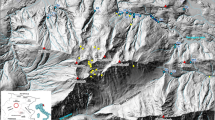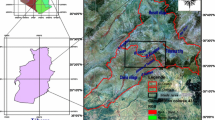Abstract
The complex karst system named Mlava–Belosavac–Belosavac 2 is one of the five systems isolated according to detailed research conducted within the Beljanica karst massif which belongs to the Carpatho-Balkanides. In order to define the genesis of groundwaters from these three springs, the deepening of the main karst channel, as well as their underground connection, a multiparameter approach has been applied consisting not only of hydrological, hydrochemical and detailed isotope research methods (stable isotopes 18O, 2H and 13C, as well as radioactive 3H and 3H + 3He isotopes), but also of cave diving exploration of the Mlava Spring. This method was performed in order to define the morphology of the main karst channels and its spatial position. The obtained results have shown that these three springs belong to the same karst system (they have the same recharge zone and relatively similar hydrochemical and isotopic characteristics, and any deviation is a consequence of a different mean residence time that water spent underground), that emerge to the surface along the contact line with hydrologic barriers through karst channels that have different depths. Also, the research has confirmed that the karst channels have well-developed systems of channels in the vertical profile, with a dominant development of deep syphonal circulation.






Similar content being viewed by others
References
Brenot A, Baran N, Petelet-Giraud E, Négrel P (2008) Interaction between different water bodies in a small catchment in the Paris basin (Brévilles, France): tracing of multiple Sr sources through Sr isotopes coupled with Mg/Sr and Ca/Sr ratios. Appl Geochem 23:58–75
Cvijić J (1896) Izvori, tresave i vodopadi u Istočnoj Srbiji. Glas - Srpska kraljevska akademija / Glas SKA 51(18):1–122
Evans CD, Reynolds B, Curtis CJ, Crook HD, Norris D, Brittain SA (2005) A Conceptual model of spatially heterogeneous nitrogen leaching from a welsh moorland catchment. Water Air Soil Pollut Focus 4:97–105
Ford D, Williams P (1989) Karst geomorphology and hydrology, ISBN 0 412 44590 5. Caphman & Hall, London
Goldscheider N (2015) Overview of methods applied in karst hydrogeology, Monograph: karst aquifers—characterization and engineering, ed. Stevanović Z., Springer, pp. 127–145
Helena B, Pardo R, Vega M, Barrado E, Fernandez JM, Fernandez L (2000) Temporal evolution of groundwater composition in an alluvial aquifer (Pisuerga river, Spain) by principal component analysis. Water Res 34:807–816
Jones AL, Smart PL (2005) Spatial and temporal changes in the structure of groundwater nitrate concentration time series (1935–1999) as demonstrated by autoregressive modelling. J Hydrol 310:201–215
Langmuir D (1984) Physical and chemical characteristics of carbonate water. In: LaMoreaux PE, Wilson BM, Memon BA (eds) Guide to the hydrology of carbonate rocks. IHP studies and reports in hydrology, vol 41, UNESCO, Paris, pp 264–265
Milanović S (2004) Speleoronjenje, značajan metod istraživanja i zaštite podzemnih voda u karstu, Vodoprivreda, 0350-0519, 36 (2004) 211-212, (Original scientific paper), pp 427–439, Belgrade
Milanović S (2006) Hydrogeological characteristic of some deep siphonal spring in the Carpato-Balkanic mountain arch (Eastern Serbia). Archives of Climate Change in Karst (Proceedings). KWI, Baile Herculane, Romania, pp 224–226. ISBN 978-0-9640258-9-2
Milanović S (2007) Hydrogeological characteristics of some deep siphonal springs in Serbia and Montenegro karst. Environ Geol 51(5):755–759. https://doi.org/10.1007/s00254-006-0391-1
Milanović S (2010) Formiranje fizičkog modela karstne izdani na primeru Beljanice (istočna Srbija), Doctoral dissertation, Department for hydrogeology, Faculty of Mining and Geology, Belgrade
Mills PC, Kolpin DW, Scribner EA, Thurman EM (2005) Herbicides and degradates in shallow aquifers of Illinois: spatial and temporal trends. Jawra J Am Water Resources Assoc 41:537–547
Palcsu L, Major Z, Köllő Z, Papp L (2010) Using an ultrapure 4He spike in tritium measurements of environmental water samples by the 3He-ingrowth method. Rapid Commun Mass Spectrom 24:698–704
Papp L, Palcsu L, Major Z, Rinyu L, Toth I (2012) A mass spectrometric line for tritium analysis of water and noble gas measurements from different water amounts in the range of microlitres and millilitres. Isot Environ Health Stud 48(4):494–511
Stevanović Z (1991) Hydrogeology of Carpathian-Balkan karst of eastern Serbia and water supply opportunities (in Serbian). Special edition, Faculty of Mining & Geology, University of Belgrade. Serbiae, pp 1–245
Stevanović Z, Ristić Vakanjac V, Milanović S, Vasić Lj and Petrović B (2011) Značaj monitoringa podzemnih voda u karstu Srbije. In: Proceedings of the 7th symposium on karst protection, Bela Palanka pp 35–42
Vasić Lj (2017) Geneza i uslovi cirkulacije voda kompleksnih karstnih sistema Kučajsko-beljaničkog masiva, Doctoral dissertation, Department for hydrogeology, Faculty of Mining and Geology. University of Belgrade, Serbia, p 389
Acknowledgements
Research presented in this paper was supported by projects from the Ministry of Education, Science and Technological Development, Republic of Serbia: Project No. OI 176022 (“Groundwater Potential as the Basis for its Sustainable Utilization”) and Project No. TR 37005.
Author information
Authors and Affiliations
Corresponding author
Additional information
Publisher's Note
Springer Nature remains neutral with regard to jurisdictional claims in published maps and institutional affiliations.
Rights and permissions
About this article
Cite this article
Vasić, L., Milanović, S., Stevanović, Z. et al. Definition of groundwater genesis and circulation conditions of the complex hydrogeological karst system Mlava–Belosavac–Belosavac-2 (eastern Serbia). Carbonates Evaporites 35, 16 (2020). https://doi.org/10.1007/s13146-020-00550-3
Accepted:
Published:
DOI: https://doi.org/10.1007/s13146-020-00550-3




